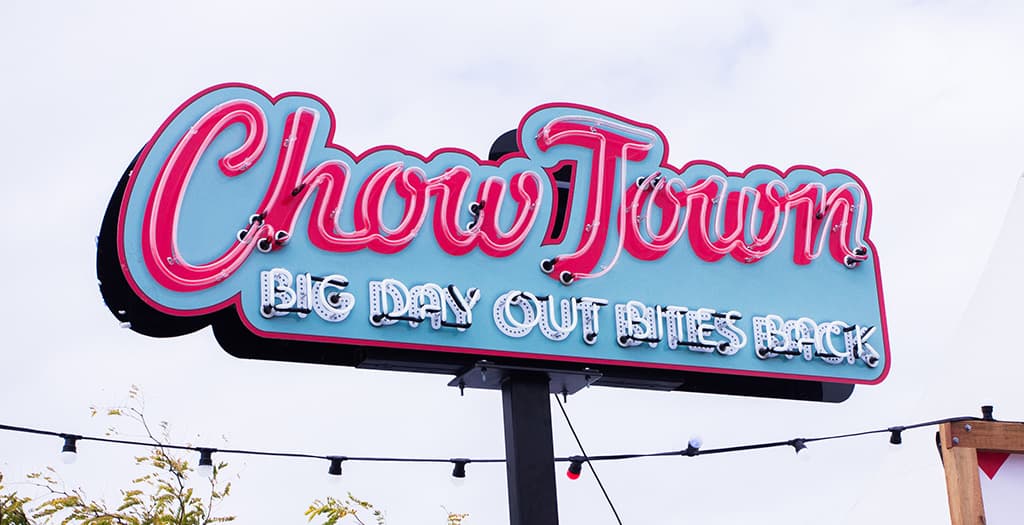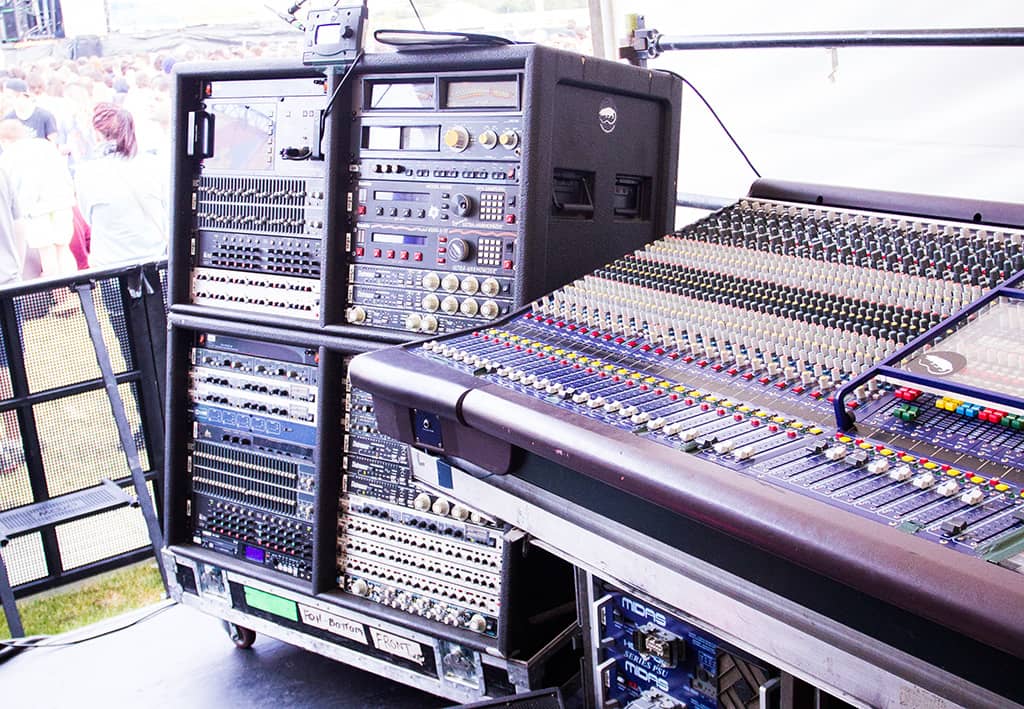
Some Like it Red Hot
This year’s Big Day Out was a return to form, and the Chili Peppers rocked the house, at least everywhere but the Gold Coast it seems. Dave Rat spills the beans on what went ‘wrong’ and sheds some light on his systematic analogue approach.
Artist Photos: Marty Philbey
It’s drawing to the end of a long Big Day Out. The sun’s set, stage lights are taking effect, video screen is back online, the Red Hot Chili Peppers are getting ready to take the stage, and their FOH engineer Dave Rat has just rocked up, laid back and smiling, unperturbed by the responsibility of mixing the festival’s headline act for close on 100,000 people. His angel assistant and partner Kim hands out beers and pours wine for friends while Dave chats to a few punters and hoists a couple of Ratsound seminar junkies over the barrier so they can watch him in action. He doesn’t even touch the console before the band make it on stage. Yet he’s relaxed, calm and ready.
Rat loves sound. He’s been mixing the Chili Peppers for 20 years, has run his own production/rental company Ratsound for 30, invented speaker designs like the Microwedge, and also worked with other big name acts like Soundgarden and Blink 182. And he’s all about sharing his experience and knowledge with like-minded people, running seminars at every tour stop for local sound engineers. Even that morning he’d flown in off a 4am lobby call in Adelaide, went straight to the seminar, finished up around 4pm, then headed over to Big Day Out still looking as fresh and excited as ever. I ask him how he can be so relaxed, and he explained that it’s all in the setup.
ALL SEEING, ALL DANCING
Rat is the only engineer on the tour running an analogue board, a Midas Heritage 3000 — everyone else is on a mix of Avid Venue Profiles, Yamaha PM5Ds, and Digico SD7s. He has the Midas set up sideways, running down the length of the FOH tent with a couple of 6-foot tall racks of outboard gear at the stage end, and a couple of measurement mics hooked up to a range of metering equipment. He positions a small rug in front of the console and his own stool adorned with a Chili Peppers logo floats nearby, but neither see more than sporadic action during the night.
If you’ve ever mixed a band in a big festival FOH tent, you’ll see the logic of not locking yourself behind the console. Typically, the desks are set up like a NASA command centre. The festival system tech sits at the very back, with the main processing gear and talkback stations connected to the stage. Next in line is the console for the opening acts, usually defacto standard Profiles, flanked by a lighting console. If the second tier headliner’s tour manager has thrown their weight around enough, there may be another console row in front with a slightly different flavour. And at the forefront is the headliner’s console. These tents are usually quite deep, and typically only the headline act’s engineer will actually be able to see the entire PA. And it’s not even guaranteed. So throughout the course of the show, you’ll see most engineers squeeze out from behind their console, head to the front of the tent and take a moment to digest the balance of the entire PA to see if it’s in line with what they’re hearing at the mix position. Rat’s setup allows him free rein of his environment.
“I see my purpose as not to make perfect sound, but to connect the artist with the audience,” he explains. “Better sound helps that, but ultimately it’s the connection. So I want to pay attention to that connection rather than hover over the board. It’s like driving a race car. I can have all the interior lights on at night, paying attention to the controls, or turn all the lights off and pay attention to the road. The road is the band and audience connection.”

MODERN ANALOGUE-Y
Everything Dave Rat does eschews the modern live sound mould, especially at festivals. It’s the luxury of having a band that recognises the importance of letting a sound engineer operate the way he wants to, and the budget to do it. While he has mixed on digital consoles before, it’s the layers that really bother him.
“I’ve mixed on digital, not by choice,” he says. “There are several reasons why people choose one or the other, usually it’s application based. If you have to patch a lot of things really fast, analogue may be a better way to go. Whereas, if you’ve got to do a bunch of different bands and store shows in the memory, then digital might be a better way to go. I don’t have a lot of scenes, or demand for digital in the way that I mix.
“If I had a lot of inputs, more than 60, and I’m muting scenes, or was mixing a band that had multiple sets on totally different instrument sections: If I was moving around pretty quick on a smaller budget and had to make concessions, then maybe. But as far as what I’m doing, the ability to see everything, and to hear something, reach over and change it instantly works for me. I don’t even have to look. I can reach over, feel where the knob is and change it while I’ve got eye contact with the band. I don’t use any board lights, and I don’t label, I just remember where everything is.”
Rat sees the Midas as less of a technical instrument to navigate with manuals and labels, but an instrument to play on. Rat knows the Midas H3000 in the same way that a guitarist can shape chords on a fretboard without looking at their hands. During the show, he looks at me while picking out channel assignments like a pop quiz. “Snare,” he says as he reaches for a fader, then sliding his hand along a few rows calls out, “Guitar.” It’s the same with EQ knobs, VCAs, sub groups — his hands flow across the console with the efficiency of a blind man reading braille.
He effuses that people who dedicate their lives like he does, in the pursuit of sound, are really chasing a fringe sense. As a population, most of us trust what we can see above all else, so for Rat, it’s about getting all of that visual input out of the way so he can better concentrate on hearing, not seeing.
My purpose is not to make perfect sound, but to connect the artist with the audience

COMPRESSOR DIAL UP
Prior to Rat’s arrival, his long-time system tech, Jim Lockyer, preps the gear and runs through the line check. But night to night, the majority of Rat’s setup stays the same. He uses his headphones as a reference. So, his EQ’ing of the individual channels is how he wants the relationship between any given microphone and its source to sound, regardless of the system EQ. Then he tunes his main graphic EQs to align what he’s hearing out of FOH to the reference in his headphones. So by and large, from gig to gig the EQ on each channel will remain static, with the only major alterations occurring in his stereo BSS FCS-960 graphic EQs.
He also typically doesn’t flatten the graphics before each show, preferring to use the previous night’s settings as a ballpark figure in the festival setting. The logic behind it seems to be that he trusts John Kerns, JPJ’s FOH system tech, to tune and time the system roughly the same for every festival, which should give Dave a pretty good starting point without potentially going flat and fighting major resonances straight off the bat.
It’s sometimes hard to follow Dave’s chains, because he doesn’t label them. But it does let you see the compressor gain reduction in action. He’s right, it is nice to be able to see how much every channel and sub group is being compressed without flipping through pages or menus.
For the most part, Dave uses Empirical Labs Distressors and Fatsos as his channel compressors, and BSS DPR-404s on his sub groups. He sets the compressor threshold to 0dB on most sub groups except for the vocal sub group, which he sets at +4dB. It means that the vocal will always want to sit on top of his mix.
He also doesn’t link the left and right compressors as a stereo pair, because he doesn’t want the listening circuit to react equally on each side. Say the guitar on the left jumps 10dB and into heavy compression, he doesn’t want the right side to be equally compressed and maintain the ratio of the loud to the soft sound. Rather, he wants the compressor on the left to rein in that spike in volume while leaving the right channel untouched.
He then also sets up two VCAs, one to control all his input channels, the other to control his sub groups. It means that he’s able to vary the compression of the entire show by balancing the two. If he wants a more compressed sound, he just has to raise the VCA with all the input channels assigned, bringing them more into compression, while reducing the level of the sub group outputs, like an overall makeup gain control. If he wants more dynamics, he just reverses that process. During the encore he demonstrates the technique, and sends the entire mix into more compression without raising the overall volume. A neat trick.




GOT THE METER RUNNING
Pride of place at the top of Dave’s rack is his measurement gear. On one side he’s got a pair of large Dorrough meters so he can simultaneously look at his average and peak levels, while on the other he has an RTA connected to a measurement mic that he uses to help EQ the system. With the exception of one broken bar he aims to get the graph on a nice descending pattern from low to high. “I use a lot of metering, I really want to know what’s going on with the system,” said Dave. “Metering’s one of the things that got lost in digital consoles. They use cheap little meters. I love the big Dorrough meters.”
SEEING RED
Before the Chili Peppers even made it to Melbourne, Dave had copped a fair bit of flak from an underpowered mix at the Gold Coast Big Day Out. Here’s his explanation: “The Killers mix the system pretty hot,” he began. “I’m trying to go for more hi-fi and clarity in my mix, whereas they’re going more for a brash, ballsy mix. When I did Sydney I mixed pretty hot straight after them. In the Gold Coast I went for a real pristine sound I was really happy with. There aren’t any delay clusters running, and I couldn’t get back there, so I didn’t know it wasn’t hitting the volume. Well, either it wasn’t hitting the volume back there, or their ears were beat up from the Killers mix. I mix 6dB lower, so their expectations are that I was going to come in hot. In Adelaide I just went back to hot again, and haven’t heard anything negative. I was very happy with the sound I was getting up on the Gold Coast. Had I had delay clusters and that sound propagated to the back we would have been in the pocket. It didn’t, it only went so far, so I’m going to have to mix hotter than what I want to mix upfront in order to get to the back of house.”
In Melbourne he mixed everything hotter, but still a couple of dB lower than The Killers. All in all, it was hugely entertaining, and loud, without ripping your head off.
















RESPONSES